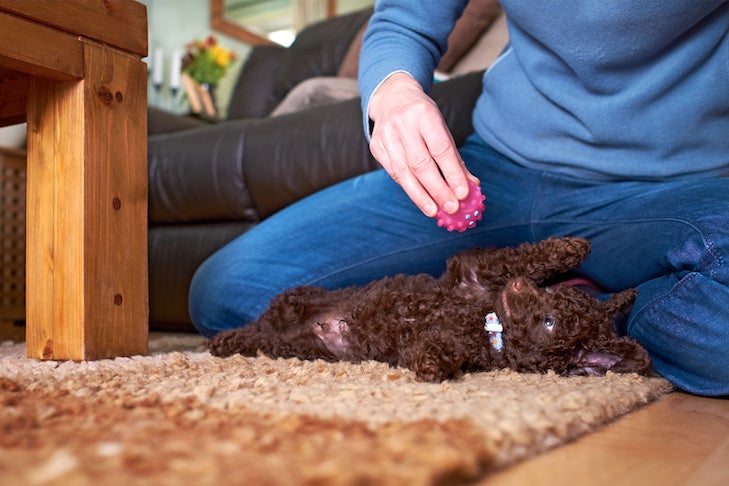
During the pandemic, online video meetings have become a common way to communicate. Whether we’re conducting business or chatting with friends and family, virtual get-togethers have made our lives easier. But there’s nothing more annoying than interruptions during a meeting. And dogs are a common culprit. Don’t let your dog be the one to bark and whine through your boss’s presentation. Read on for tips to keep your dog quiet during online video meetings.
Provide Attention and Exercise
A dog who wants food, attention, or a potty break is going to make their needs known with demanding behaviors like barking, whining, or pawing you. And that’s incredibly distracting during a meeting. Of course, you can mute your microphone so nobody else is disturbed, but it will be impossible for you to focus. The obvious solution is to meet your dog’s needs beforehand.
If your meeting is around your dog’s normal mealtime, feed them early rather than expecting them to patiently wait until you’re done. You should also take them out for a potty break right before your meeting starts to ensure they’re comfortable for the duration of your meeting. And if you can, provide your dog with some exercise and play ahead of time as well. If you give them a chance to burn off excess energy and soak up some attention, they will be far more likely to relax afterward.
Give Your Dog a Chew Toy
It’s difficult for your dog to watch you on a video call. From their perspective, you’re simply ignoring them and that’s no fun. Instead, give your dog something to occupy their time. If they’re engaged in an exciting activity, they won’t care what you’re doing on your computer.
An edible chew, like a bully stick, is a great option to keep your dog busy. Look for something long-lasting and safe for your dog’s chewing style. For example, rawhide chews could be safe for a light chewer but not if your dog can break off large chunks. That can pose a choking hazard or lead to an intestinal blockage. Remember, you won’t be supervising your dog, so only use chews you know from previous experience are appropriate.
You can also provide food releasing chew toys. The classic Kong is ideal. Stuff the Kong with peanut butter or cream cheese layered with treats so your dog has to work past the sticky filling to get to the other goodies. To make the toy last even longer, freeze it first. There are loads of recipes for Kong stuffers on the web, so try a few out until you find one that keeps your dog busy for as long as possible.

Occupy Your Dog’s Mind
You can also keep your dog out of your hair with puzzle toys and slow feeders. These challenge your dog’s mind as they try to find the hidden food. Look for a puzzle toy that doesn’t require reloading every few minutes. Although these toys are fantastic, they are meant to be used with your dog rather than for solitary play. Instead, try food-filled toys that your dog must manipulate like a rocking treat dispenser or a snuffle mat. Set up one or more of these toys right before your meeting and your dog won’t even notice you’re gone.
Slow feeders are meant to slow down your dog during mealtime. But there’s no reason you can’t use them at other times to engage your dog. Simply sprinkle in a few treats or bits of kibble and let your dog work out how to remove them. You can even make your own food-releasing puzzle toys from items you have around the house.
Teach the Quiet Cue
Even if you’ve given your dog plenty to do during your video call, they might still bark. Whether they’re excited by a squirrel in the yard or want to tell you about the mail delivery, it’s helpful if you can ask for quiet. A “quiet” cue tells your dog to stop barking, and it’s relatively easy to teach.
Simply hold a tasty treat to your dog’s nose while they’re barking. As soon as they stop barking to take a sniff, praise them and reward with the treat. Once they begin to catch on, wait for a half second of silence before offering the reward. Then build the length of time until your dog can be quiet for several seconds. Now it’s time to fade the lure and add a verbal cue like “quiet.”
Because barking is so rewarding in itself, you’ll need to practice training “quiet” often and in many situations before your dog masters this behavior. And be sure to add a hand signal like placing a finger over your lips so you can ask for silence during a meeting without even needing to mute your microphone.
Send Your Dog to Their Bed
Finally, give your dog somewhere relaxing to spend their time when you’re busy online. Send your dog to their place (a bed, crate, or mat) until your video call is over. If you’ve used positive training techniques to teach this behavior, your dog will have built wonderful associations with their place and will be content to spend time there. However, you should still give them an activity to do while they are there such as chewing a bully stick or playing with a food-stuffed toy.
The AKC is here to help owners with questions and concerns about COVID-19 and dogs. Find answers to your questions, plus at-home activity ideas, training tips, educational resources, and more on our Coping With COVID-19 hub.

